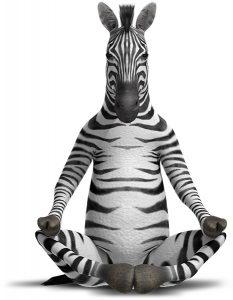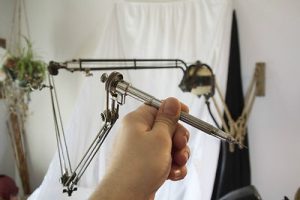Why Zebras Don’t Get Ulcers – Hint: It’s all about stress
The title of this blog, Why Zebras Don’t Get Ulcers, is the title of one of my favorite books about stress, written by Robert M. Sapolsky.
Stress has always been a special interest of mine, perhaps because when I was little, I experienced it vividly, not knowing what it really was. One of my biggest stresses? Going to the dentist.
If you are not a baby boomer, you have no idea of why we found this so stressful. Here are some of the reasons:
The needle
The shot of Novocain that you got to eliminate the pain was not the super sharp, flexible needle you get today. It was a rigid needle made of stainless steel, and because it was expensive, the dentist would keep it in a jar of alcohol, using it over and over again! Yes. What was going into your mouth had been in up to 16 other person’s mouths. And if you were among the last recipients, it would be quite dull. Just seeing the needle on the top shelf, in a jar of alcohol was enough to trigger the stress reaction.
The drill
The drill was not high-speed by any means. It was powered by a series of rubber belts. Here is what it looked like:
Did it vibrate? Yes. Did it ever slow down from the hardness of the tooth? Yes. And about that drill – Yep! It too was used in several mouths.
The dentist
The dentist himself, (back then almost all dentists were men,) wore neither gloves nor a mask. If it were early afternoon, you could definitely tell what he had for lunch. Hopefully it wasn’t a salami and onion sandwich!
The nerve ending in the tooth
It seemed like no matter how much Novocain the dentist had used, it did not end up in the right place. You just knew that at some point in the procedure, a raw nerve would be drilled, causing you to jump. The solution? Grit it and bear it. There would be no more Novocain. And so you spent the entire procedure waiting for that moment that was going to make you jump in pain.
Okay, enough about early dentistry. The point is, this is but one of the things that caused us stress. Other things were more mundane, and common to our current stress-filled lives: Deadlines, traffic jams, relationships, and the big one: money.
Which stress event would you put at the top of your list? Try this before you read the rest of the article: Write on a piece of paper the three things that most cause you stress.
Going back to the title of this blog, and the title of Sapolsky’s book, imagine yourself now to be a zebra. Make another list of the three things that most cause you stress. It would be a much different list, would it not? It would likely contain things like outrunning the lions that are trying to kill you and eat you, finding food and water during a drought, recovering from an illness in a place where you still need to fight for your very existence. All of a sudden, arguing with your kids or your spouse doesn’t sound quite so stressful. And if you are the lion, you need to outrun the zebra or you will have spent a tremendous amount of energy, and are now both completely fatigued, and still hungry. Traffic jams, you say? Meh!
Zebras don’t get ulcers because their stress reaction is used for exactly what it was meant to be used for. But for us humans, these pesky things set off our stress reaction. And because we have so many of them throughout our day, we are in a state of constant chronic stress. This very thing that was meant to prepare you to expend vast amounts of energy in the space of less than a minute is now constantly setting off for no reason at all. Hence – ulcers.
Why Yoga Helps
When you see a running meet, perhaps while watching the Olympics, and all the runners are at the “ready,” do they look relaxed? No. They have purposefully tightened all the muscles of their bodies because it is easier to get up to speed from that initial burst of energy if the muscles are already tight. If instead they held their bodies completely relaxed, then when the starting gun sounded, they would have to first tense their muscles to make them work quickly.
Tensing muscles is exactly what the stress reaction does (among many other things,) to prepare you for a stressful event. In the case of the lion and the zebra, it is preparing them for the fight of their lives. In the case of thinking about money problems it is preparing you for…nothing!
When we practice yoga, we stretch most of the muscles of our bodies. This is why I always try to include in the classes I teach: standing poses, sitting poses, backward bending poses, forward bending poses, twisting poses, and inverted poses. All that stretching removes the tense muscles you have, wherever they might be.
At the end of class, when we do deep relaxation, we are invoking the “relaxation response.” In the late 60s, a physician, Herbert Benson, found a counterbalancing mechanism to the stress response. It was its complete opposite. When elicited, it did the following:
- Decreased metablolism
- Slowed down breathing
- Relaxed muscles
- Slowed the heart rate
- Reduced blood pressure
- Increased levels of nitric oxide
Following is a quote from the Benson Henry Institute: “Regular elicitation of the relaxation response has been scientifically proven to be an effective treatment for a wide range of stress-related disorders. In fact, to the extent that any disease is caused or made worse by stress, the relaxation response can help.”
So there you have it. The prescription to reduced stress is a good yoga class; one that includes stretching many muscles, and includes a deep relaxation at its end. Of course you can also reduce stress by reacting to it differently, but that is a topic for another blog.



Hello, I think that this is a really intersting article!✔✔😂👍👌 although the dentist part I think was a bit wierd because it has NOTHINGGGGG to do with zebras not having ulcers!😮
So relate to the dentist stress!!!!